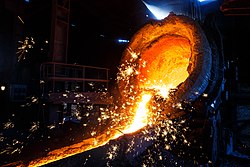| Steels |
|---|
 |
| Phases |
| Microstructures |
| Classes |
| Other iron-based materials |
The SAE steel grades system is a standard alloy numbering system (SAE J1086 – Numbering Metals and Alloys) for steel grades maintained by SAE International.
In the 1930s and 1940s, the American Iron and Steel Institute (AISI) and SAE were both involved in efforts to standardize such a numbering system for steels. These efforts were similar and overlapped significantly. For several decades the systems were united into a joint system designated the AISI/SAE steel grades. In 1995 the AISI turned over future maintenance of the system to SAE because the AISI never wrote any of the specifications.[1]
Today steel quotes and certifications commonly make reference to both SAE and AISI, not always with precise differentiation. For example, in the alloy/grade field, a certificate might refer to "4140", "AISI 4140", or "SAE 4140", and in most light-industrial applications any of the above is accepted as adequate, and considered equivalent, for the job at hand, as long as the specific specification called out by the designer (for example, "4140 bar per ASTM-A108" or "4140 bar per AMS 6349") is certified to on the certificate. The alloy number is simply a general classifier, whereas it is the specification itself that narrows down the steel to a very specific standard.
The SAE steel grade system's correspondence to other alloy numbering systems, such as the ASTM-SAE unified numbering system (UNS), can be seen in cross-referencing tables (including the ones given below).
The AISI system uses a letter prefix to denote the steelmaking process. The prefix "C" denotes open-hearth furnace, electric arc furnace or basic oxygen furnace steels, while "E" specifies only electric arc furnace steel.[2][3] A letter "L" within the grade name indicates lead as an added ingredient; for example, 12L14 is a common grade that is 1214 with lead added for machinability.
Suffixes may be added to the steel grade which specify the forming process used to create a part. These may include cold working (CDS), hot working (HR), quenching and tempering (Q&T), and other methods.
- ^ Bringas, John E. (2004). Handbook of Comparative World Steel Standards: Third Edition (PDF) (3rd ed.). ASTM International. p. 14. ISBN 0-8031-3362-6. Archived from the original (PDF) on January 27, 2007.
- ^ Jeffus 2002, p. 635.
- ^ Degarmo, Black & Kohser 2003, p. 115.